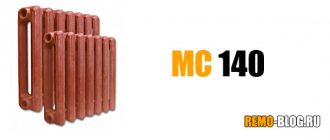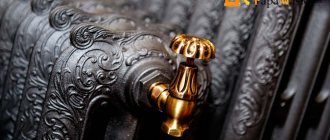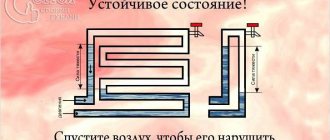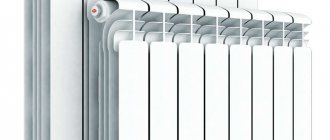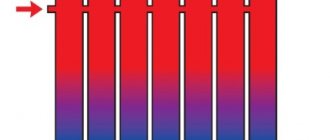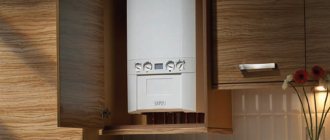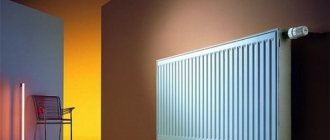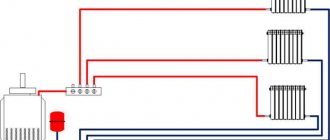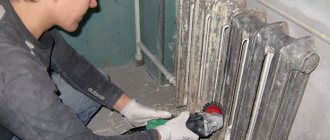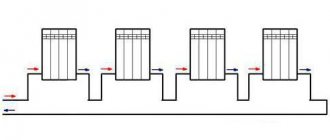Indicators influencing the calculation of the number of sections
When choosing a radiator for a particular room, you need to take into account technical features. For example, the calculation will be different for a corner and non-corner room, for a room with different ceiling heights and different window sizes, etc. The most important parameters that are taken into account when determining the required radiator power are:
- the area of your premises;
- floor;
- ceiling height (above or below three meters);
- location (corner or non-corner room, room in a private house);.
- will the radiator be the main heating device;
- There is a fireplace and air conditioning in the room.
There are other important features that need to be taken into account. How many windows are there in the room? What size are they, and what kind of windows are they (wooden; double-glazed windows for 1, 2 or 3 glasses)? Was additional insulation of the walls done and what kind of insulation (internal, external)? In a private house, what matters is the presence of an attic and how insulated it is - and so on.
Cast iron radiators Conner (China)
According to SNIP, 41 W of thermal energy is required per 1 cubic meter of space. You can take into account not the volume, but the area of the room. For a 10 sq.m standard room with one door and one window, one door and an outer wall, the following heat output of the radiator will be required:
- 1 kW for a room with one window and an outer wall;
- 1.2 kW if it has one window and two external walls (corner room);
- 1.3 kW for corner rooms with two windows.
In reality, one kilowatt of thermal energy heats:
- In houses made of brick with a wall thickness of one and a half to two bricks, or made of timber and log houses (window and door area up to 15%; insulation of walls, roof and attic) - 20-25 sq. m
- In corner rooms with walls made of timber or brick of at least one brick (area of windows and doors up to 25%; insulation) - 14-18 sq. m
- In the premises of panel houses with internal cladding and a thermally insulated roof (as well as in the rooms of an insulated dacha) - 8-12 sq. m
- In a “living trailer” (wooden or panel house with minimal insulation) – 5-7 sq. m.
Dimensions and weight of cast iron heating radiators
The parameters of cast iron radiators using the example of the domestic product MS-140 are as follows:
- height – 59 centimeters;
- section width – 9.3 centimeters;
- section depth – 14 centimeters;
- section capacity – 1.4 liters;
- weight – 7 kilograms;
- section power 160 watts.
You can hear complaints from property owners that it is quite difficult to move and install radiators consisting of 10 sections, the weight of which reaches 70 kilograms, but the good news is that such work in an apartment or house is done only once, so the dimensions of cast iron heating radiators must be correctly calculated.
Since the amount of coolant in such a battery is only 14 liters, when thermal energy comes from the boiler of an autonomous heating system, then you will have to pay for the extra kilowatts of electricity or cubic meters of gas.
Design features of heating devices made of cast iron
Initially, heating elements were made of cast iron, because this material has all the necessary properties for long and reliable operation of the heating system.
Modern cast iron radiators have a more attractive appearance than their first prototypes. Otherwise, the principle of battery operation remains the same.
Cast iron radiators for heating private houses are made of a gray alloy, which is poured into special molds. All models are sectional, connected to each other using seals. The power of the equipment is determined by the number of such sections, which allows the buyer to purchase a radiator taking into account the area of the room.
The width of the device also varies. It depends on the number of channels through which the coolant moves, giving off heat to the air. Modern cast iron radiators have one, two or three channels. Accordingly, the more there are, the wider the device.
Selection, installation and operation of cast iron heating batteries
Stages of installing a radiator to a heating system.
If the choice (lightweight radiators or cast iron) is made in favor of the latter, then you need to calculate the number of batteries in the room and the number of radiators in each of them. To do this, you need to know the technical characteristics of a particular model, first of all, the amount of heat generated. Another important task is to determine the location for installing the batteries and the method of mounting: wall or floor. Based on this, a specific sample is selected. Photos of almost most cast iron heating radiators can be found on the Internet. Cast iron radiators have different external volumes, including being quite voluminous or completely flat, and having different heights and widths.
A common place in a living room where you can install a battery is a niche located under the window sill. Its parameters dictate the size of the battery. The technical characteristics of this battery should provide 1 kW of heat per 10 m² of room area. Moreover, if the volume of the room is larger than usual due to the high ceiling, or there is a second window, then 1.2 kW of heat is needed for the same area. If the room occupies a corner position, it makes sense to add a few more extra sections, since there is more heat loss there.
The mounting method dictates both the weight of the battery and the strength of the wall near which it is placed. If it is hung on the wall, then it is worth remembering that at least three brackets are needed for each battery. Today, cast iron batteries often use floor mounts, and many models have ready-made legs. If the wall is made of wood, then you should use corner fasteners. Next, you need to carefully install the pipes supplying the coolant and screw them on, ensuring the tightness of the threads as much as possible. At the same time, do not overdo it in applying force so as not to tear it off, otherwise water will leak.
https://youtube.com/watch?v=8l2cyQIMvMQ
Repairing a cast iron battery most often consists of eliminating leaks at the connection points with the pipes. The question arises: how to wash the radiator from the inside? It also has a simple, albeit time-consuming solution. It is disconnected from the battery, and then with the help of a flexible brush and a hose with high water pressure, all accumulated dirt is easily washed out. Like repairs, this procedure is best left to a specialist. Independent steps can be quite successful, but they can also lead to damage.
Cast iron batteries will become an uninterrupted and reliable source of heat for you, your children and grandchildren.
Advantages and disadvantages of cast iron batteries
Bad and inefficient radiators are a big problem. Not only do they not guarantee adequate space heating, but they also have low energy efficiency. This, in turn, increases the cost of heating and, consequently, the burden on the family budget.
The problem with cast iron radiators is often found in old buildings where a complete modernization of the heating system is necessary. However, in many cases it is worth replacing only cast iron radiators to improve comfort and minimize costs. To make the whole process go quickly and without difficulties, select batteries that will be fully adapted to the existing heating system and at the same time modern and proven.
Advantages and disadvantages of cast iron batteries
Advantages
Most people who choose heating elements for a new home do not even consider using cast iron radiators, believing that they are outdated. The reality is somewhat different. Modern cast iron radiators are now available in various shapes. Their modular design allows them to precisely match the power emitted into the room.
Another important advantage of cast iron radiators is the parameters of the material from which they are made. Cast iron is characterized by high corrosion resistance and minimal sensitivity to the chemical composition of water. Can be combined with any materials used in the heating installation. Their durability (up to 50 years of operation) and affordable price continue to make them popular.
Flaws
Cast iron batteries, although they last a long time, sooner or later fail due to the appearance of sinks or clogging of the watercourse with salts and small particles found in the coolant. Therefore, it is advisable to replace cast iron batteries before they completely fail.
Cast iron batteries are extremely inefficient; they work with large amounts of water, so they heat up and cool down slowly. Changing the temperature in the house takes quite a long time, which has a negative impact on thermal comfort. This is especially noticeable during the off-season, when you need to turn on the heating for a short period of time.
Cast iron radiators are heavy, so installing them on an interior partition made of lightweight materials - plasterboard, thin-walled gas blocks - will be very problematic.
An additional disadvantage of cast iron radiators, which we usually encounter in older buildings, is the lack of automatic temperature control - thermostats. Such an outdated system creates additional heat costs.
Comparative table of parameters of heating radiators of different types:
Replacing cast iron batteries – saving money!
The most correct replacement scheme is to modernize the entire heating system. Remember, replacing cast iron radiators with modern installations does not guarantee a reduction in heating costs, and in some cases it may even increase them. This happens, for example, when a new modern gas boiler is installed, operating with completely different parameters that differ from the parameters of cast iron radiators. Therefore, in such a situation, it is better not to refuse to install new heating devices, since such imaginary savings can cost much more in the future.
For a heating system to function efficiently and economically, all its components must be compatible and correctly selected. The benefits of replacing cast iron radiators will be obvious after the first heating season. The best proof would be lower gas bills.
How to reduce the cost of heating in a house or apartment
Do not cover the battery. Even if the radiator in the room doesn’t look very aesthetically pleasing, or the rules of Feng Shui force you to put a bed in this place, don’t do it. By blocking the heat source, even with curtains, we make it difficult for air to move properly in the room. The radiator heats up more without proper heat transfer. The minimum distance between the heater and furniture should be at least 10 cm.
If you are not in an apartment, do not turn on the heating. Turn off radiators before leaving for work. If no one is home all day and the radiators are running at full capacity, you are wasting money unnecessarily. It is worth considering the habit of turning off radiators before leaving.
Close the door in a heated room. It is much easier to warm a small room than a large living room. Warm air leaves the room into the cold hall only through an open door. Thanks to this simple action, you can maintain a higher temperature in a separate room.
Seal windows and other places through which heat can escape. At the same time, do not forget to ensure minimal air circulation between rooms. Complete insulation can lead to moisture problems and can even be dangerous when you have a gas installation in your home.
Ventilation is short and intense. It is better to open windows wide for a short period of time than to leave them half open for a long period. Check the radiators. Sometimes we don't even realize that radiators are not working efficiently. If the radiator is set to the maximum temperature and does not heat up well, this may mean that air has entered the system. Don't forget to bleed your radiators before each heating season!
Install reflective film on the wall behind the radiator. It can be purchased at any building materials store. The film is inexpensive and will give you really big savings! If the radiator is located under a window, install the film under the window sill and on a section of the wall equal to the area of the radiator. The heat is reflected from the film and returned to the apartment.
Share:
Aluminum radiators
Aluminum devices have higher heat transfer than other types of heating batteries. They also have a large flow area. Thanks to these features, they provide quick heating of the room and make it possible to regulate the temperature. They are also light in weight.
These radiators are made of aluminum alloy and coated with powder enamel. Most often they are used in private homes with an autonomous heating system, since they last a long time only with low operating pressure and clean coolant. For houses connected to a central main line, aluminum batteries are not suitable due to the fact that sudden pressure changes occur in such systems. Aluminum is a lightweight material, so it may not withstand high pressure and simply burst.
But for private buildings such radiators are ideal. To make your home cozy and warm, and for your heating appliances to last a long time, you just need to monitor the cleanliness of the coolant and the pressure in the system. To maintain a comfortable temperature, it is recommended to install special thermostats.
If water is used as a coolant, then aluminum radiators must be washed once a year with running water under pressure. This does not pose a problem if the heating system was created from plastic pipes with quick-release connections. In this case, the radiator can be easily removed, washed and then installed back in its place. Aluminum batteries have a beautiful appearance. The front appears flawless, smooth and beautiful. Despite the fact that unevenness always occurs during the casting of sections, they are not visible on the finished product. Judging by their appearance, the batteries may appear to be made of plastic. The sides of the sections are also evenly painted. The back and interior are coated in one thin layer, but since the composition is of high quality, the paint does not flake or peel off.
The main difference between these two types of aluminum radiators is their appearance; the performance characteristics are almost identical.
Comparison of cast iron and aluminum radiators
Since cast iron and aluminum batteries differ in a number of key parameters, they need to be compared separately. The right choice can be made only after studying all the characteristics.
Which batteries heat better: cast iron and aluminum?
There is no better option in terms of achieving the required indoor air temperatures; both types of radiators are quite effective. At the same time, cast iron takes a long time to “stoker”; it will take hours to warm up the room. Aluminum is a convenient option to use because it provides the fastest heating possible. Literally 20 minutes after switching on the rooms will become quite warm.
Important! Aluminum radiators are often installed in modern houses with autonomous heating. Regulating the heat supply and media flow in such systems is simple and convenient.
Aluminum heats faster, cast iron holds heat better
Aluminum radiators, despite all the advantages, have certain disadvantages. So they should be replaced more often than cast iron ones; such products are highly susceptible to pressure drops inside the system, and in critical situations they can simply burst.
Important! Aluminum's main competitor is bimetal, the most modern and advanced alloy. It has one minus - the price.
Which batteries hold pressure better?
The latest models of cast iron radiators have very thick walls, about 4-5 mm. In practice, this means that such products perfectly withstand the pressure of the coolant in the system if it exceeds the standard values of 8 atmospheres. And even if the parameter increases to 12 atmospheres, this still will not create a threat to the walls.
Aluminum radiators are made from alloys with different thermal conductivity parameters. They normally withstand the pressure of the coolant inside the system, but, of course, worse than cast iron ones. Older models were designed for 7-8 atmospheres with a wall thickness of 2-5 mm, modern ones operate at 12-15 atmospheres.
Cast iron and aluminum are approximately equal in terms of their ability to withstand pressure surges in the system
Comparison of maximum coolant temperature
The maximum coolant temperature for aluminum is about 100 °C; cast iron can easily tolerate temperatures of 120 °C or more. This parameter is not particularly relevant for old houses, since they have an acute problem of insufficient heating in principle. But if increased loads are planned, it would be safer to bet on cast iron.
Cast iron radiators are a 100% reliable choice, but in appearance they are inferior to aluminum products
Durability and service life
Cast iron is practically eternal - with proper care and normal coolant quality, the service life of the products will be at least 50 years. Aluminum batteries need to be replaced every 15-20 years as they are prone to corrosion and deterioration.
The main disadvantage of aluminum alloys is their tendency to corrosion.
Easy to install
Cast iron radiators are installed using welding technology. It is allowed to use gas welding, but this method is more expensive. The homeowner decides whether to pay more or not; the main advantage of gas welding is the exceptional durability of the system, high resistance to wear and pressure surges.
When installing a heating battery, aluminum blanks are connected to each other using argon welding. The method gives a strong, durable connection. The result will be structures of phenomenal strength.
You can install heating batteries yourself
Radiator cost comparison
Cast iron batteries are more expensive than most aluminum ones, although designer models of the latter type are on par with cast iron products. The high price tag is fully paid off during operation. A section of an aluminum radiator costs about 350 rubles or more, a cast iron one costs twice as much.
Cast iron is a choice for years, but aluminum is cheaper
Appearance comparison
Cast iron batteries are a classic, but you shouldn’t count on an abundance of designs here. With aluminum, you can implement projects of varying complexity. Exclusive execution usually leads to a sharp increase in the cost of the section.
Your wishes for appearance should definitely be taken into account when choosing batteries.
What is heat transfer and power of radiators
The power of cast iron heating radiators and their heat output are among the main characteristics of any device that provides room heating. Typically, manufacturers of equipment for heating structures indicate this parameter for one section of the battery, and the required number is calculated based on the size of the room and the required heat transfer of cast iron radiators.
In addition, other factors are taken into account, such as the volume of the room, the presence of windows and doors, the degree of insulation, climatic conditions, etc. The heat output of heating radiators depends on the material they are made of. It should be noted that cast iron is inferior to aluminum and steel in this matter. The thermal conductivity of this material is 2 times lower than that of aluminum. But this drawback is compensated by the low inertia of cast iron, which gains heat and releases it for a long time.
In closed heating systems with forced circulation, the efficiency of aluminum batteries will be much greater, but subject to the presence of an intense coolant flow. As for open structures, cast iron has more advantages with natural circulation. The approximate power of one section of a cast iron radiator is 160 watts, while for aluminum and bimetallic devices the same parameter is within 200 watts. Therefore, under equal operating conditions, a cast iron battery should have a large number of sections.
Pros and cons of cast iron radiators
Batteries, or radiators as they are also called, are a very important part of any heating system. Therefore, consumers take the issue of choosing heating radiators for their homes quite seriously. A lot depends on the right choice. This includes warmth in the room, savings on heating costs, interior design, and, of course, comfort. When making your choice, you must first pay attention to the reliability, safety and durability of radiators. No less important is how well the radiators perform in heating the room - their main function. And, of course, an important criterion is cost.
Until recently, the main type of household heating appliances were cast iron radiators. In Soviet times, almost every new resident who received an apartment where panel steel radiators were installed tried to replace them with cast iron radiators after the first heating season. Today you can hear the most controversial statements about cast iron radiators. Some believe that they should be used in the future, as they have proven themselves over a long period of operation, while others argue that they are “old,” and more modern heating devices should be used. Both of these statements are wrong because they are based only on emotions. But what if we look at this issue from a logical point of view? Unfortunately, to date, no one has yet invented a universal heating device that meets all the requirements.
Each heating device has its own advantages and disadvantages. What are the advantages and disadvantages of cast iron radiators?
Firstly, cast iron radiators have high corrosion resistance. This advantage is due to the properties of the cast iron itself. The used cast iron surface is covered with so-called dry rust and this practically eliminates further corrosion. In addition, cast iron is not affected by the unsatisfactory quality of the coolant, and the solid particles present in it (pebbles, small fragments of rust, etc.) are not able to significantly damage the internal surface of the radiator, and, therefore, abrasive wear is quite insignificant.
One of the factors ensuring the durability of cast iron radiators is the significant thickness of their walls. It follows that cast iron radiators can be used in heating systems where there is a high oxygen content (open) and in systems that are periodically emptied (as a rule, in high-rise buildings, water is drained from the heating system during the summer season). When used in such conditions, steel radiators will rust after a few seasons.
Cast iron radiators are characterized by high heat storage capacity and thermal inertia. An hour after turning off the heating of the heating system, the residual heat transfer of cast iron radiators is 30%, which is 2 times more than that of steel ones. This ability allows the use of cast iron radiators in heating systems where irregular heating is possible (systems with solid fuel boilers).
Another advantage of cast iron radiators is that they can be used for quite a long period without cleaning. This possibility is provided by the large internal cross-section. In addition, such an internal cross-section makes it possible to operate cast iron radiators in systems with low coolant circulation rates.
Quite a long service life. Some manufacturers limit the service life of high-quality cast iron radiators to 30 years, but this figure is significantly underestimated. A 50-year service life for a cast iron radiator is not the limit. And if it is operated in a system with high-quality coolant, then it will be able to achieve 100 years of “service life” without any problems.
As noted above, today there is no ideal radiator. Likewise, cast iron radiators, along with all the listed advantages, also have their disadvantages. One of the disadvantages of cast iron radiators is their significant weight. Only 1 section (without water) weighs about 7 kg. In addition to the fact that such weight creates difficulties during transportation and installation, serious problems with fastening may arise if the walls are not strong enough (for example, drywall). For such cases, some manufacturers equip radiators with special legs for mounting on the floor.
They are inferior in strength to their “competitors”. Water hammer is undesirable for cast iron radiators. The optimal pressure for them should not exceed 15 atm, while for bimetallic radiators this figure is 40.
Coolant for cast iron radiators
One of the significant advantages of cast iron models is their insensitivity to various coolants. There is no need to monitor the acidity levels of the circulating fluid. The width of the channel makes it possible to freely pass through and not allow impurities to accumulate inside, of which there are a huge number in central heating systems.
Cast iron radiators do not enter into chemical reactions with antifreeze, water or other liquids containing anti-freezing additives. However, this does not mean that you can forget about water treatment. Indeed, in addition to the batteries, the coolant flows through pipe lines, inside the boiler and other installed equipment.
Positive characteristics of cast iron radiators
Any coolant is suitable for them
While technical hot water reaches the battery from the boiler room, its quality does not improve. However, it was not ideal initially, and then, following the pipelines, it takes with it a fair amount of impurities. So a certain liquid is already entering our apartments, quite aggressive in chemical terms. This very aggressive water (more specifically, it contains a lot of alkalis) also carries with it a bunch of small grains of sand that act like abrasives.
And it begins to actively corrode steel batteries, for example. And grains of sand, like sandpaper, rub their thin walls. But cast iron doesn’t care about all this - after all, it is chemically passive, and the walls of radiators made of this metal are very thick. And in the summer, when the water is drained from the system, the cast iron battery will not rust from the inside.
Maximum working pressure
The operating pressure of cast iron radiators ranges from 9 atmospheres or more, depending on the manufacturer and model. They withstand water hammer well and are therefore often used in central heating systems.
Durability
If you wash cast iron batteries from time to time, and also replace the intersection gaskets as necessary, then they will respond gratefully to such care. They will be able to work for fifty years, properly heating your rooms. By the way, retro batteries made of cast iron, which were cast at the first factories, are still alive in St. Petersburg. More than a hundred years have passed, after all.
Low price
If we compare the price of cast iron batteries with the cost of bimetallic products that have become fashionable recently, then cast iron will be much more profitable on a budget. And if you have to buy radiators not for one room, but for several, then the savings will be very, very impressive.
Technical characteristics of cast iron radiators ms 140
At the moment, in our country, cast iron heating radiators MS 140 can be called the most common model of heating devices. These devices are manufactured in accordance with GOST 8690–94. Depending on the distance between the axles, there are five standard sizes of MS 140 batteries: 300, 400, 500, 600 and 800 mm.
Previously, all standard sizes were used quite widely, and they could be seen not only in residential apartments, but also in administrative and industrial buildings. At the moment, the most commonly used cast iron radiators are MS 140 500 and 300. Other modifications are extremely rare and, as a rule, they are made to order.
In view of the popularity of ms 140 500 batteries, you should consider the technical parameters of this model. For heating cast iron radiators brand MS 140, the characteristics are given for one section, since this is a purely sectional model. By selecting the required number of sections, you can create the optimal temperature regime in the room.
The main characteristics of heating radiators MS 140 500 are as follows:
- pressure. Working pressure is up to 9 atmospheres, and pressure testing is up to 15 atmospheres;
- heat transfer is low and equals 175 W;
- each section has two channels;
- section dimensions: height – 50 cm, width – 9.8 cm;
- the capacity of one section is 1.35 liters of water;
- The radiator is able to withstand coolant temperatures up to +130 degrees.
It is worth considering the design of a cast iron heating battery model ms 140 500. Gray cast iron is used for production. Nipples are made of malleable cast iron. Gaskets are installed between the sections. Heat-resistant rubber is used to produce gaskets.
Cast iron radiators - technical characteristics
When choosing cast iron batteries for the heating system of a house, apartment or cottage, there are certain rules. And, first of all, take into account the main technical parameter - the heat transfer of cast iron radiators, which depends on the area of the entire room in which these heating devices are located.
Cast iron radiators are not out of fashion!
Next, you should pay attention to the weight of the cast iron battery. Namely, how much does a section of a cast iron battery weigh? And also how much does the entire cast iron battery weigh and what is its thermal power, height, width, depth of the radiator, etc.
So, let's look at how to choose cast iron heating radiators and characteristics. For a private house or apartment, as a rule, radiators are used that are designed for a working pressure of 6 atmospheres. To find out the power of cast iron radiators for each room, use a simple calculation of heating devices:
Cast iron battery in a small room
- If the room has 1 window and an external wall, then for heating 10 sq. m area, a thermal power of 1 kW is sufficient.
- If the room has 1 window and 2 external walls - for every 10 sq. m of heated area of a cast iron radiator will require a power of 1.2 kW.
- If the room has 2 windows and 2 external walls - for every 10 sq. m. - power 1.3 kW. Next, to determine the power of cast iron radiators, you need to calculate the required number of sections for one room. And also how much power one section of the heating device produces.
Cast iron radiator MS-140 is reliable, easy to use and inexpensive.
By the way, the most common heating devices are cast iron radiators MS-140, which are installed in both civil and industrial facilities.
For more information about this, read the article on our website “Cast iron radiator ms 140”.
Calculating the power of a cast iron radiator
You can calculate the number of sections for cast iron heating devices using a variety of methods. In specialized books there are methods that include a large number of factors, including the area of the room, the location of windows and doorways, the material and structure of the walls, technical indicators of batteries, etc.
However, you can obtain the desired value using a simpler formula: multiply the area of the room by 100 and divide by the power of one section.
The result obtained should be corrected as follows:
- In rooms with a height of more than 3 m, 1-2 sections are added to compensate for heat losses
- Adding several sections is necessary for rooms where two walls border the street
- In rooms with two window openings, radiators are installed under each of them, dividing the found number of sections equally. This is necessary so that air barriers are formed under the windows for cold through flows from outside.
- The fractional value is always increased in a positive direction
Classic cast iron radiators are not much different in appearance. However, the development of the heating appliance market and the constant change in the style of the interior forced manufacturers to come up with something new, more elegant and extravagant.
Today, the market offers models of various color palettes (gold plated, silver, copper, bronze, etc.). There are radiators with artistic castings on which ornaments are applied.
However, external design significantly affects the cost. Decorative models are much more expensive than classic, modern aluminum, steel or bimetallic ones.
Video instructions for assembling sections
Having examined in more detail the features and technical characteristics of cast iron heating radiators, you can get your own idea about these heating devices. However, it is impossible to claim their great superiority over other models. The reason is that each of the proposed options has its pros and cons.
Due attention should be paid to cast iron models when designing a heating system. You can purchase them in a maintained condition to save money and not have to worry about them breaking down soon.
Disadvantages of cast iron heating radiators
Modern model
Heavy radiator weight. If we take into account how much one section of a cast iron heating radiator weighs (7.12 kg MS-140 Soviet version), then a seven-section radiator together with water will weigh 60 kg. In addition, they are bulky and often protrude beyond the window sill, thereby spoiling the appearance of the room.
The high thermal inertness of the cast iron alloy cannot always be considered an advantage, since this property makes the radiator ineffective for use in an automatic temperature control system.
Smaller heat transfer surface area compared to other types of radiators. In addition, the thermal conductivity of cast iron is less than that of aluminum, bimetallic, and steel counterparts.
If heating devices are installed near walls made of lightweight structures, then they are mounted on special brackets and stands.
Maintenance comes down to removing dust not only from the rough surface of the product, but also between the sectional gaps, which is not entirely convenient. However, this must be done, otherwise the dust will be carried by warm air throughout the apartment.
Outdated design. The old design of radiators does not fit into the European-quality renovations of recent years. The solution is to hide them behind decorative screens, make niches for them, and replace them with more modern ones.
Modern design of cast iron radiators
The new Progress radiator model
is not marking time, and manufacturers have developed new models that are significantly superior in design to their predecessors.
Having considered the advantages and disadvantages of cast iron radiators, supporters of cast iron do not take into account the disadvantages and want to install only cast iron in their apartment, but of a new generation.
Some of today's models are close in design to their aluminum and bimetallic counterparts. They have a wonderful modern look, the front part is made of a flat panel.
If earlier the improved version was supplied from Turkey, China, Italy and other countries, today they are produced in Russia, Belarus, and Ukraine.
When comparing our batteries and products from foreign countries, we are inferior to them in terms of quality and some technical characteristics. This affects the price accordingly - it is much higher for foreign manufacturers.
Cast iron radiators in retro style
Retro style
For lovers of exclusivity, manufacturers can offer a retro style option. This is not only a radiator, but also a decorative decoration for your home, that is, as they say, two in one.
They are available in different geometric sizes, heat transfer, capacity, weight, design, and can be painted in any color. The surface is covered with cast patterns; they are installed retro on legs cast together with the radiator.
If you want to purchase a retro one, then with its original design it will harmoniously fit into any interior and become an exclusive warming decor in your home.
Perhaps the only drawback can be considered its cost, but a small compensation may be that the radiator does not need to be hidden and covered with protective screens and curtains, since it is beautiful.
You can consider the advantages and disadvantages of cast iron radiators for a long time and compare them with modern bimetallic, aluminum and other counterparts. To summarize the above, as long as the heating networks and equipment remain in their current state, cast iron batteries can be considered the best option.
Advantages compared to other batteries
- The undeniable advantage of a cast iron radiator over modern aluminum, steel, and bimetallic batteries is its durability. The half-century anniversary of the cast iron battery is a ubiquitous phenomenon. In some cities, the batteries that were cast in the century before last have survived to this day and continue to work properly.
- The cost of a cast iron product can only please the future owner - European prices for trendy aluminum or bimetallic batteries are not affordable for everyone. In addition, purchasing a large number of sections promises significant benefits.
- Another advantage of cast iron is the absence of any coolant requirements. Water of any quality is poured into the heating system.
- The thickness of the cast iron sections allows them to withstand the highest operating pressures. starting from 9 Atm and above. In addition, cast iron withstands water hammer very well, which is why it is preferred in centralized heating systems.
Recommendations for choosing heating batteries
Externally, bimetallic radiators resemble aluminum ones; it is difficult to distinguish them. Without specific knowledge, visual differences are not easy to see. However, when it comes to performance characteristics, bimetallic batteries are much better than aluminum ones.
The best radiator currently is bimetallic. It is durable and can withstand high pressure, so it can also be installed in multi-storey buildings with a centralized heating system. As for aluminum products, they cannot always be used.
It is not recommended to use them in cases where:
- There is high pressure in the heating system
. Since aluminum is a brittle metal, if the maximum permissible pressure is exceeded, the product may not withstand and leak. For this reason, aluminum radiators are not used in multi-storey buildings connected to a central highway. - Non-freezing liquids, which are incompatible with aluminum, are used as coolants
. If such a coolant comes into contact with this metal, a chemical reaction occurs, leading to the destruction of the heating device. - The boiler has a copper heat exchanger
. Copper and aluminum are incompatible materials, since they form a galvanic couple, between which an electric current arises, destroying both elements. Aluminum suffers the most because its ions are attracted to copper. As a result, over time, the walls of the heating device will become thinner and may leak. However, such a problem will not arise if metal-plastic or polypropylene pipes were used to create the heating system - in this case, galvanic couples are not formed.
Panel steel radiators are used exclusively in autonomous heating systems. These batteries can be used with any coolant and even with copper heat exchangers. Steel radiators are quite durable, but they are susceptible to rust.
All types of heating radiators have certain advantages and disadvantages, so the choice depends on the specific situation. As for the characteristics and operating conditions, bimetallic radiators are the best, but not every family can afford to buy them.
Details about the types of heating batteries in the video:
Recommendations for selection and installation
The selection of this type of battery comes down to determining the required number of sections for heating a particular room and the appropriate standard size. To do this, you should know the required thermal power or approximately calculate it by quadrature, and take the heating radiators with some margin. If we take as a basis that for each m2 of area you need 100 W of thermal energy, then for a room of 10 m2 you will need 1 kW of heat, and sections of the MS device 140 500 - 1000 / 160 = 6.25, 7 pieces are taken.
For northern regions, an increasing coefficient of 1.5 to 2 must be applied to the value of thermal power, and for southern regions, a decreasing index of 0.7 must be applied.
Radiators are installed to an external wall in accordance with the diagram.
To fasten MC 140 batteries, 2 types of brackets are used: steel and cast iron.
There are paired brackets welded with a strip, which are best used when mounting on a wall made of porous materials. They can be attached to the surface at several points.
External design features
Cast iron radiators are produced only in factory conditions; mostly gray cast iron is used for these purposes. The radiator is made up of separate sections or “teeth”, each containing a round or oval shaped channel through which the coolant will move. Sections can be single-channel or double-channel. Next, the sections are assembled into a single battery, they are joined together, and heat-resistant gaskets are laid for tightness. The size of the battery will depend on the number of sections.
The size of heating radiators made of cast iron can be different; various models with different section parameters are now produced. The size is selected individually depending on the area of the room, insulation and the number of window and door openings in the house. The size of radiators can vary from 50 to 140 centimeters in depth, from 35 to 150 centimeters in height, the width is chosen based on the number of sections.
Batteries are manufactured using the casting method. Therefore, the design is sealed and reliable. Cast iron perfectly accumulates and releases heat, suitable for autonomous and centralized heating systems. Cast iron batteries have a high wear resistance and service life. They withstand pressure surges well; the operating pressure in the battery is nine atmospheres. They are also not picky about the coolant; fine sand and scale when hot water moves cannot cause significant damage to the channels inside the sections. For central heating systems, where the coolant “acquires” a good supply of chemical elements during its journey, cast iron is also suitable, since the metal does not react and does not rust.
What types of cast iron radiators are there?
Cast iron heating radiators, like a construction set, are assembled from separate sections cast from gray cast iron under production conditions. The recesses for coolant flow can be round or elliptical. To connect individual sections, nipples are used, which provides for additional sealing of the joints using heat-resistant gaskets made of rubber or paronite.
According to the number of channels in one section, cast iron radiators can be:
- Single-channel.
- Two-channel.
The width of the batteries may vary depending on the number of sections. The same goes for heights. When choosing the appropriate width of a sectional cast iron radiator, they are guided by the volume of the heated room, the number of window openings, and the thickness of the external walls. The level of thermal power of the battery directly depends on the number of its sections. The height of the products can be from 35 to 150 cm. There is also such a parameter as the depth of the radiator: it helps to determine whether the heater will fit into the decor of the room or not.
Radiators with a depth of 50-140 cm are available for sale: they are installed using special mounting brackets, pre-fixed in the wall. They provide not only a strong hold on the suspended battery, but also a gap between its back surface and the wall. More modern cast iron radiators are equipped with special legs (more details: “Modern cast iron heating radiators - characteristics, advantages, connection rules”).
Heat transfer calculation
First of all, it is recommended to pay attention to the existing data sheet, which is attached to each product of this type. In it you can find the necessary information regarding the thermal power of one section of the product
These figures need significant correction. The heat transfer of bimetallic heating radiators, like aluminum ones, have excellent power ratings, and the judgment is based on the well-known fact that copper products have an excellent level of heat transfer, as well as aluminum ones. They have a high thermal conductivity, while heat transfer depends on many other factors.
Heat transfer from the heating radiator is multiplied by a correction factor taken depending on the DT value
The figure indicated in the passport is correct only if the difference between the supply and processing temperatures is 70°C.
Using the formula, calculations are made as follows:
The instructions may have different symbols. Often only a difference of 70°C is mentioned and nothing more.
How to calculate heat transfer and power of radiators
In order to always maintain a comfortable temperature in the room, it is necessary to correctly calculate the heat transfer of heating devices and select them in accordance with the required characteristics.
This is the only way we can correctly calculate heating radiators so that the room is warm and comfortable in cold weather.
The thermal power of the heating device is indicated in its passport. However, this parameter may vary depending on actual operating conditions. The calculation of heat transfer from a radiator is determined based on the temperature difference - the difference between the average temperature of the coolant and the air in the room:
where Твх – coolant temperature at the inlet;
Тout – temperature of the coolant at the outlet;
Troom – air temperature in a heated room (a value of 20 degrees is considered comfortable).
In the technical specifications, the temperature regime is designated as Tin/Tout/Troom. and the temperature pressure is Tnap. If the heating system has indicators that differ from the values specified in the passport, then the thermal power of the radiator should be calculated using the formula:
where k is the heat transfer coefficient of the heating device (indicated in the passport);
A – area of the heat transfer surface of the radiator (indicated in the passport);
Tnap – temperature pressure.
By calculating the power of the heating battery, you can determine the required number of batteries or select a specific type of heating device that has sufficient heat output to heat a particular room.
Advantages of cast iron heating radiators
Old model
Resistance to corrosion processes, since cast iron practically eliminates this phenomenon. When interacting with the coolant, which acts as a kind of oxidizer, the inner surface of the radiator becomes covered with a coating, the so-called “dry rust,” which prevents corrosion from penetrating deeper.
The quality of the coolant was described above. The composition of cast iron and the thickness of the walls make it possible to use any coolant, which cannot be said about other types of batteries, which gradually become overgrown with rust. Cast iron is practically invulnerable to abrasive wear, chemical impurities, and aggressive coolant acids.
Excellent thermal inertness. Cast iron heating radiators are good because they are able to hold heat and release it if the system suddenly turns off or the supply temperature of the coolant decreases.
The heating system, as a rule, is emptied during the non-heating season in residential areas of apartment buildings, which risks oxygen entering it, which increases the ability to oxidize.
Cast iron sections, due to their characteristics such as corrosion resistance and mechanical properties, are used in systems with the presence of oxygen. The same advantage applies to partially open heating systems.
Reasonable price, the ability to add or remove several sections depending on the temperature in the room, ease of maintenance and installation are an important advantage.
Long service life. The batteries can be used for 30-40 years. If necessary, they should be washed. In houses of the old sector, they “live” from the day the house was built - up to 50 years, there are examples of this.
Considering the advantages and disadvantages of cast iron radiators, we will also dwell on their weaknesses.
Explanations of comparative values of heating appliances
From the data presented above, it is clear that the bimetallic heating device has the highest heat transfer rate. Structurally, such a device is presented by RIFAR in a ribbed aluminum housing. in which metal tubes are located, the entire structure is secured by a welded frame. This type of battery is installed in high-rise buildings, as well as in cottages and private houses. The disadvantage of this type of heating device is its high cost.
Important! When this type of battery is installed in houses with a large number of floors, it is recommended to have its own boiler station, which has a water treatment unit. This condition for the preliminary preparation of the coolant is associated with the properties of aluminum batteries
they can be subject to galvanic corrosion when it is supplied in poor quality through the central heating network. For this reason, it is recommended to install aluminum heating devices in separate heating systems.
Cast iron batteries are significantly inferior in this comparative system of parameters; they have low heat transfer and a large weight of the heating device. But, despite these indicators, MS-140 radiators are in demand among the population, the reason for which is the following factors:
Duration of trouble-free operation, which is important in heating systems. Resistance to the negative effects (corrosion) of the thermal fluid. Thermal inertia of cast iron.
This type of heating device has been operating for more than 50 years; for it there is no difference in the quality of the preparation of the thermal fluid. They cannot be installed in houses where the operating pressure of the heating network may be high; cast iron is not a durable material.
Comparative findings
The heat transfer of aluminum radiators is slightly lower, although they are lighter and cheaper than bimetallic ones. In terms of test and operating pressure, aluminum devices can also be installed in buildings of any number of floors, but subject to: the presence of an individual boiler room with a water treatment unit. The fact is that aluminum alloy is susceptible to electrochemical corrosion from low-quality coolant inherent in central networks. It is better to install aluminum radiators in separate systems.
Cast iron radiators differ sharply from others. the heat transfer of which is significantly lower with a large mass and capacity of the sections. It would seem that with such a comparison they would not find application in modern heating systems. Nevertheless, the traditional MS-140 “accordion” continues to be in demand, their main trump card is durability and resistance to corrosion. Indeed, gray cast iron, from which MS-140 is made by casting, can easily serve for up to 50 years or more, and the coolant can be anything.
In addition, a conventional cast iron battery has high thermal inertia due to its massiveness and capacity. This means that when the boiler is turned off, the radiator remains warm for a long time. As for the operating pressure, cast iron heaters cannot boast of high strength. Purchasing them for networks with high water pressure is risky.
